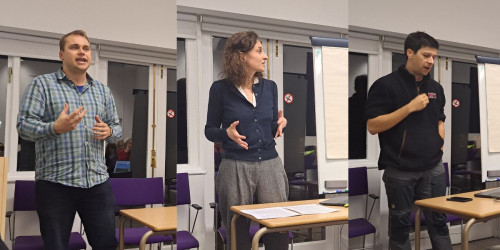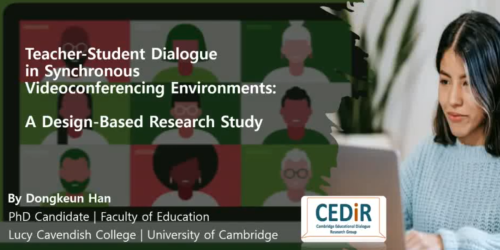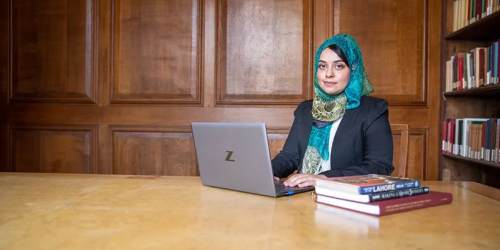
Research at Lucy: talks by our Fellows
Lucy Cavendish Fellows tackle climate change with their interdisciplinary and ground-breaking work.
Lucy Cavendish College researchers showcase their interdisciplinary and innovative projects.
On 25th October, the College’s JRFs presented their findings to the College community. The evening featured the following talks:

Dr Suhail Dhawan: Cosmic Expansion and Exploding Stars
Supernovae are some of the brightest explosions in the universe. They are signposts of the end stages of the lives of stars. Owing to their brilliant display in several colours, they can be used to measure distances and infer the details of the composition, evolution and expansion history of the universe. A particular class of supernovae, known as Type Ia, have been used to measure the present rate of expansion of the universe - known as the Hubble Constant - very precisely. My talk will be centred on novel methods to measure the Hubble Constant with Type Ia supernovae.

Dr Maria Zacharopoulou: Designing protein-DNA nanostructures against intracellular targets in cancer
Cancer remains a significant global health concern, with a prediction that 1 in 2 people born in the UK after 1960 will be diagnosed with some form of cancer in their lifetime. While there have been notable advancements in cancer therapies over the past few decades, there's still a pressing need to develop innovative approaches that can enhance their effectiveness, reduce side effects, and tackle hard-to-treat cancer types. Cancer cells are known to have disrupted cell signalling pathways, resulting in uncontrolled growth and proliferation. A promising strategy for developing effective cancer treatments involves targeting specific proteins within these pathways to regulate their activity. In my fellowship project, I will target such a pathway using a hybrid DNA-protein drug. We can use DNA to construct minuscule structures, known as DNA origami, which can transport the therapeutic moiety into cells and directly to our intended target.

Dr Rihab Khalid: Linking gender, energy and space-use for just and sustainable cities
Buildings and spaces are not gender-neutral. Their design impacts men and women in different ways that have significant implications for sustainability. Yet, limited focus is given to how gender equity interlinks with other development goals like universal energy access and sustainable growth of cities. In this short presentation, I will share insights from my three-year research journey at Lucy and delve into some of the dynamics of the gender-energy-space nexus, and why taking this intersectional approach is critical for just and sustainable future transitions.

Dr Juan Benito-Moreno: The origin and early evolution of modern birds
During the Jurassic and the Cretaceous periods, between 160 and 66 million years ago, early birds became very diverse and adapted to most terrestrial and marine environments, yet most of the Mesozoic bird diversity disappeared together with non-avian Dinosaurs when an asteroid impacted the Yucatan peninsula at the end of the Cretaceous 66 million years ago. Only the lineage including the ancestors of all living birds survived the Mass extinction, to then diversify into the incredible diversity of birds that we can observe today. However, how the ancestors of living birds relate with other Mesozoic bird groups is controversial, and what are the morphological features that distinguish modern birds from their closest Cretaceous relatives, and whether these played a part in the differential survival of the living bird lineage is yet unclear. In order to explore these questions, I work with bird fossils spanning the transition between Cretaceous birds and the earliest modern birds. To do so I use cutting-edge computerised tomography scans of fossil and extant species to describe in detail their anatomy and use phylogenetic and high-dimensional geometric analyses to evaluate their evolutionary relationships and how their morphology correlates with ecological factors. My work has provided the most complete and exhaustive morphological characterization of any Mesozoic bird, helped resolve long-standing controversies about the phylogenetic relationships of key pre-modern Cretaceous birds, and overturned hundred-year-old assumptions on the evolutionary nature of the modern bird skull.

Dr Lorena Gazzotti: Looking for Godot. Development aid, migrant children, and the externalisation that wasn't at the Spanish-Moroccan border
Over the past 30 years, the migration of unaccompanied and separated children from North Africa to Europe has attracted considerable attention from European politicians. Migrant children create a contradiction for the modern state: on the one hand, the state is obliged to provide care and protection to minors; on the other hand, the security reflex of the security apparatus apprehends them as foreigners to control and deport. This talk will take the story of a former military building in Tleta Taghramt, on the outskirts of Tetouan, Morocco, to investigate the paradoxes that the political will to deport migrant children produces on the ground. We will retrace how Spain tried to utilise international development cooperation to set up return mechanisms for Moroccan migrant children under the care of Spanish child protection structures, the political and civil society struggles that emerged around such efforts, and why this building in Tleta Taghramt never actually ended up hosting Moroccan migrant children returned from Spain.

Lucy Cavendish Fellows tackle climate change with their interdisciplinary and ground-breaking work.

PhD student, Dongkeun’s research looks into how students and teachers can interact effectively in videoconferencing.

Rihab’s research looks at gender, energy, space use, and socio-technical transitions.